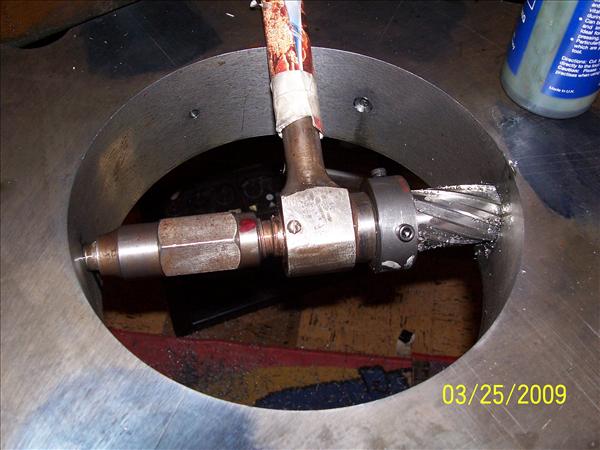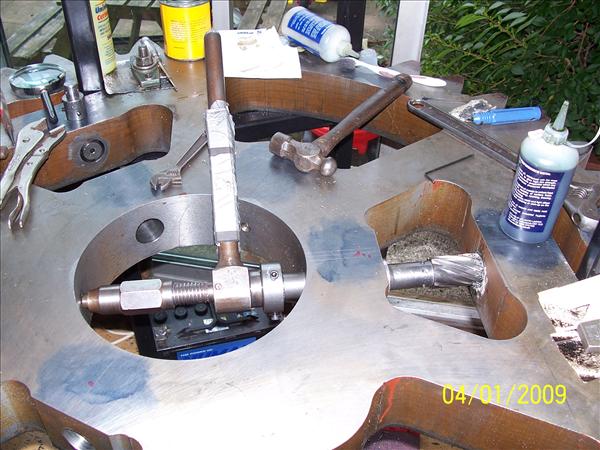Some sort of ratcheting hand drill
| Rainbows | 25/04/2015 10:44:16 |
| 658 forum posts 236 photos | I had to shrink the image cause it was a bit big but I think everything can still be seen. Debating buying this tool. Looks like the child of a ratchet spanner and a drill press. Can anyone think of what its used for? Drilling is there for when needing slow speed I suppose and it allows the use of more tapered reamers in hand use. |
| roy entwistle | 25/04/2015 11:01:35 |
| 1716 forum posts | They were used on the railways for drilling railway lines Also as an apprenice electrician we used them for drilling RSJs |
| terry simpson 1 | 25/04/2015 11:03:17 |
| 18 forum posts | Remember this tool, used as a portable hand drilling machine on equipment where access or lack of power was not available to use. Example:- On site drilling of railway fishplates, or by Boilermakers when drilling is needed in the confines of tanks and vessels. The drill is really incomplete as the bolt on or fixed backstop is needed to apply downward pressure to the drill point. I would suggest that the tool, apart from being a talking point, would have very limited uses in the home workshop. This is my opinion however, the brains of our fraternity have not yet replied to this query. |
| Bob Brown 1 | 25/04/2015 11:06:49 |
1022 forum posts 127 photos | There is another part which bolts/clamps to the work piece and allows the top to sit in a centre hole (drilling post). There is one write up on its use here **LINK** Bob |
| Clive Foster | 25/04/2015 11:07:58 |
| 3630 forum posts 128 photos | Old technology version of a mag base drill for producing relatively large holes on site. Basic method of use is to make a small pilot hole to locate the drill point then arrange some sort of screw jack or equivalent to put feed pressure on the pointed centre at the top. Then ratchet away whilst adjusting the screw to keep pressure on. Surprisingly fast in anything but the most obdurate materials as a sharp drill will take a very thick chip. Often its possible to find a solid point in the main structure to support the pressure screw. If this isn't possible there is normally there is some sort of upright in the kit which can be fixed to the work surface by clamps or drilled holes with a cantilever arm carrying the pressure screw. Yours is a pretty modern example being arranged to take morse taper drills rather than square drive end variety used with earlier types. Looks as if it has the pressure screw built into the device too. Which is often more convenient than having it on the arm or jack. The Cole drill and other similar devices are a lighter duty version working on similar principles. If you anticipate putting holes over a 1/2" or so into metal structures too big to get under the shop drill it may be worth having about the place. Clive. PS. Bob, thats a superb link you found about these devices. Well done.
Edited By Clive Foster on 25/04/2015 11:14:50 Edited By Clive Foster on 25/04/2015 11:15:44 |
| Rainbows | 25/04/2015 11:41:06 |
| 658 forum posts 236 photos | So am I right to say the only thing missing is a sort of half arch which I attach to the workpiece and then butt the pointy but at the top against the other end of the arch? Got a few days to go, might buy it might not. |
| Jesse Hancock 1 | 25/04/2015 11:50:38 |
| 314 forum posts | Yeah thank god for mag drills and generators. Good clean example though. |
| WorkshopPete | 25/04/2015 12:53:40 |
| 87 forum posts | Hi All I remember when serving my time one of the engineers who was ex navy apprentice and went all through the war - torpedoed twice in the Atlantic - telling he was in a shipyard in the USA the ship had suffered deck damage and being the age it was had all the plates riveted. He and several others were set to with ratchet drills to drill the hundreds of holes needed in this armoured plate meanwhile the Americans were bringing on board various mag based drills which all failed to drill a single holes while Charlie and his mates were very slowly plodding on. Old technology! Peter
|
| Clive Foster | 25/04/2015 15:15:19 |
| 3630 forum posts 128 photos | Peter No surprise that early mag based drills couldn't cope with armour plate or similar. Low speed & high pressure being the generally accepted way to cope with that sort of 'orrid stuff. Your basic mag drill of that era would have run too fast as well as being too weak in the magnet to hold against the required pressure. It took a fair few years for carbide technology to evolve to the point where anything approaching normal drilling methods could be made to work. A good example of how effective pressure at low speeds can be is the oft cited party piece for a Cole drill is to push a hole straight through a bearing race, tool steel or similar hard material without great effort using a good quality masonry drill. Has to be very slow, probably 30 rpm or so equivalent. Clive.
|
| norman valentine | 25/04/2015 16:48:14 |
| 280 forum posts 40 photos | It can also be used in a confined space where you can't get a full swing with a normal brace.
|
| Clive Hartland | 25/04/2015 21:24:29 |
2929 forum posts 41 photos | The arm that is attached to the vertical pillar is machined with a myriad of Vee cavities to take the pointed end. This so you could match any angle or position. Very slow and deliberate and I did an apprentice course where they thew one of those at me to drill a hole in a sheet of plate. Luckily i knew what to do and sailed through it. Clive |
| Harry Wilkes | 25/04/2015 22:37:54 |
1613 forum posts 72 photos | Takes me back to the 'dark days' when I earned a tanner an hour (2.5p) .................................. H |
| IanT | 26/04/2015 09:24:12 |
| 2147 forum posts 222 photos | My starting pay in HM Armed forces was 10 shillings a week (50p) Harry - but it was "all found" So you got paid on Thursday (hold out left hand, receive cash and paybook, shout "Pay & Paybook correct Sir!", step smartly back and salute) - went out that night and were broke come Friday morning but at least you had your food and bed for the week! Happy Days IanT
|
| paul 1950 | 27/04/2015 10:15:21 |
| 143 forum posts 32 photos | here is one showing the jack screw |
| JasonB | 27/04/2015 10:29:47 |
25215 forum posts 3105 photos 1 articles | Pic of one being used in a "home workshop" even though teh guy has a very extensive workshop you would be hard pushed to do this by other means. Carl Byrne's Fowler final drive being drilled for diff pinions scale 12"/Ft
|
| paul 1950 | 27/04/2015 11:04:49 |
| 143 forum posts 32 photos | impressive maybe I should remove it from eBay |
| Dave Bond 1 | 27/04/2015 13:42:21 |
| 12 forum posts | Looks to be quite efficient. The time stamps on the photos show drilling one hole only took 8 days ***tongue in cheek*** |
| Rainbows | 27/04/2015 16:35:56 |
| 658 forum posts 236 photos | Postage is a bit of a killer for me and Ive seen something else that might deserve my money better. I don't think there is a rule against it so here is a link if any of you want to try it. |
| paul 1950 | 27/04/2015 17:57:29 |
| 143 forum posts 32 photos | £1.35 of the postage will go to eBay so he is not asking over the top |
| HughE | 02/05/2015 00:24:53 |
| 122 forum posts | I think there was an article to make a smaller version for restoring a main frame of an engine. Can't rember if it was MEW or ME. |
Please login to post a reply.
Want the latest issue of Model Engineer or Model Engineers' Workshop? Use our magazine locator links to find your nearest stockist!
Sign up to our newsletter and get a free digital issue.
You can unsubscribe at anytime. View our privacy policy at www.mortons.co.uk/privacy
- *Oct 2023: FORUM MIGRATION TIMELINE*
05/10/2023 07:57:11 - Making ER11 collet chuck
05/10/2023 07:56:24 - What did you do today? 2023
05/10/2023 07:25:01 - Orrery
05/10/2023 06:00:41 - Wera hand-tools
05/10/2023 05:47:07 - New member
05/10/2023 04:40:11 - Problems with external pot on at1 vfd
05/10/2023 00:06:32 - Drain plug
04/10/2023 23:36:17 - digi phase converter for 10 machines.....
04/10/2023 23:13:48 - Winter Storage Of Locomotives
04/10/2023 21:02:11 - More Latest Posts...
- View All Topics
- Reeves** - Rebuilt Royal Scot by Martin Evans
by John Broughton
£300.00 - BRITANNIA 5" GAUGE James Perrier
by Jon Seabright 1
£2,500.00 - Drill Grinder - for restoration
by Nigel Graham 2
£0.00 - WARCO WM18 MILLING MACHINE
by Alex Chudley
£1,200.00 - MYFORD SUPER 7 LATHE
by Alex Chudley
£2,000.00 - More "For Sale" Ads...
- D1-3 backplate
by Michael Horley
Price Not Specified - fixed steady for a Colchester bantam mark1 800
by George Jervis
Price Not Specified - lbsc pansy
by JACK SIDEBOTHAM
Price Not Specified - Pratt Burnerd multifit chuck key.
by Tim Riome
Price Not Specified - BANDSAW BLADE WELDER
by HUGH
Price Not Specified - More "Wanted" Ads...
Do you want to contact the Model Engineer and Model Engineers' Workshop team?
You can contact us by phone, mail or email about the magazines including becoming a contributor, submitting reader's letters or making queries about articles. You can also get in touch about this website, advertising or other general issues.
Click THIS LINK for full contact details.
For subscription issues please see THIS LINK.
Model Engineer Magazine
- Percival Marshall
- M.E. History
- LittleLEC
- M.E. Clock
ME Workshop
- An Adcock
- & Shipley
- Horizontal
- Mill
Subscribe Now
- Great savings
- Delivered to your door
Pre-order your copy!
- Delivered to your doorstep!
- Free UK delivery!














 Register
Register Log-in
Log-in


